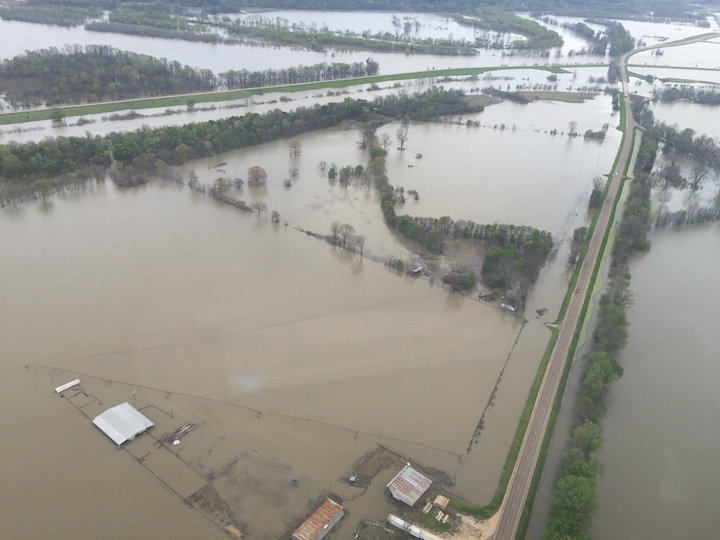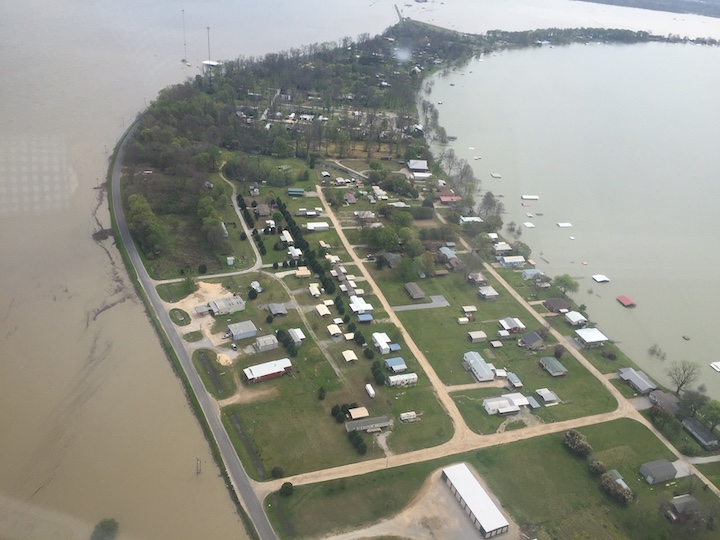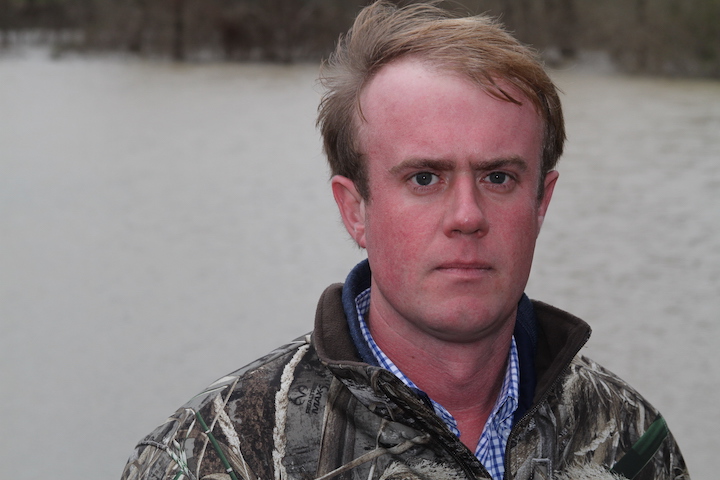EPA Fiddles as Flood Clock Rolls on Mississippi Delta’s Forgotten Nightmare
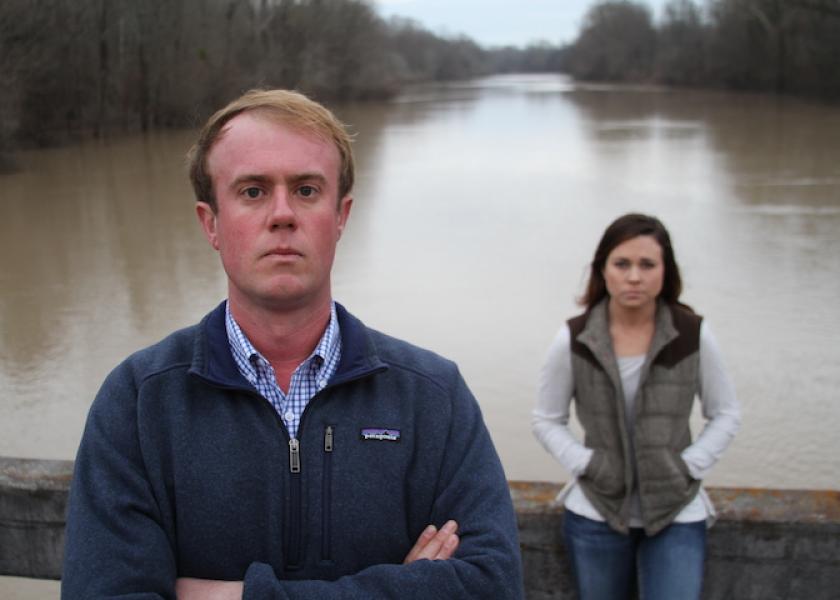
If ever a nightmare saga tangled government bureaucracy and politics with science and the backdoor dealings of a federal agency, the Yazoo Backwater Project stands front and center.
Welcome to the Mississippi Delta’s bureaucratic taffy pull, where Environmental Protection Agency officials stand guard over a bathtub of Delta floodwater and refuse to pull the plug, while politicians engage in repeated rounds of navel-gazing, and the livelihoods of 20,000 U.S. citizens and hundreds of farmers hang in the balance.
The Yazoo Backwater Project is an 80-year stop-and-start tale of political indecision, with all government actions wrapped in science under the banner of the Clean Water Act.
“Science? Anybody who genuinely believes our flood crisis is about science could only be from Washington,” says Smith Stoner, a fourth-generation farmer from Yazoo County. “Here’s some guaranteed science: It’s gonna flood again very soon and destroy the lives of thousands of people, cost taxpayers billions of dollars, and turn the Delta into an environmental dead zone, all because the EPA won’t allow the building of relief pumps. If you want to know how corrupt our government really operates, then look at our story—it’s mind-boggling.”
Gordian Knot
Across decades of repeated floods, the citizens (30% below the poverty line) of the South Delta have waited on Army Corps of Engineers construction of a pump system to protect their homes and farmland, as promised by the U.S. government in 1941, through approval of the Yazoo Backwater Project. That was then; this is now.
The overall Mississippi Delta (2.62 million acres) is generally a flood-prone region, but the South Delta (926,000 acres), tucked between the Mississippi and Yazoo rivers, is a water receptacle with a single drain—the four-gated Steele Bayou Drainage Structure in Issaquena County, 10 miles north of Vicksburg. When the Mississippi River gets high, it backs into the South Delta, and in response, the Corps of Engineers closes the Steele Bayou floodgates to ensure the South Delta is not inundated by the rising Mississippi River.
However, the drainage system is both servant and master: It protects the South Delta and holds it prisoner. When the Steele Bayou floodgates are closed, the Delta drain is clogged. In 2019, the backwater reached 98.2’, resulting in a historic flooding event. The vista from fabled Highway 61 was pulled from the pages of water-world fiction: A drive on 61 south of Rolling Fork revealed an ocean stretching to the horizon.
The 2019 South Delta flood featured five months of ruin and it ranks among the most heavily ignored and needless catastrophes in recent U.S. history. A massive chunk of the South Delta was swallowed, evidenced by 548,000 acres of land underwater for nearly half a year, including 231,000 acres of cropland never planted in 2019. Multiple deaths, 686 homes swamped, three highways under water, and 20,000 people pleading for pump relief from the federal government.
The near guarantee of the massive 2019 flood was the worst kept backwater secret of the past 45 years and was openly predicted by South Delta homeowners and landowners since the 1970s, encapsulated by a persistent “Build the Pumps” rallying cry. Mississippi farmers kicked and screamed at the feds for decades, warning of a cataclysm around the corner, and in 2019, the predictions were toe-tagged with a vengeance that left a region in tatters, and forced EPA officials to reckon with a policy train wreck.

At present, the cost to build a pump system for the South Delta is approximately $400-$500 million—a high number on first blush. However, in comparison with perpetual flood costs, $400-$500 million might be considered a bargain for taxpayers. Why? From 2008-2018, the South Delta sustained $372 million in flood damage, and the bill from the calamitous 2019 flood—by itself—is well over $1 billion, estimates Peter Nimrod, chief engineer of the Mississippi Levee Board. “The pumps will pay for themselves in no time,” Nimrod says. “The math is simple and everyone knows it.”
But the math and the dollars are not the source of the figurative and literal clog associated with Yazoo pumps. Rather, the impediment is tangled in a Gordian knot cinched tight by EPA.
Snowflake in Summer
In 2008, EPA vetoed South Delta pumps, citing environmental concerns over wetlands destruction. By bureaucratic fiat, the region was prevented from obtaining flood protection and left perpetually exposed to high water.
Over a decade after EPA’s veto and shortly after the 2019 flood disaster, Congressman Bennie Thompson (D-MS 2nd District), issued a press release on Feb. 7, 2020, imploring EPA to reverse its 2008 decision and underscoring the sense of urgency by tossing in “critical” and “vital” as telltale adjectives: “This project is of critical importance for the second congressional district of Mississippi,” as well as, “it is vital for us to remedy this problem.” [emphasis added]

Indeed, EPA reversed course at the end of November 2020 and approved the kickoff of pump construction, a building process slated to last four years. In a green-light letter to the Corps, EPA Region 4 Administrator Mary Walker wrote, “The EPA fully supports the purpose of the project to reduce flood damages in the Yazoo Backwater Area.”
After decades on pause, EPA’s message was crystal clear: Build the pumps. (The $400 million cost was designated as a split between construction and reforestation. The pump units would kick on at 87’, leaving roughly 215,000 acres of the South Delta still flooded, but the compromise was considered manageable by the Mississippi Levee Board.)
Four score and a handful of days after the initial Yazoo Backwater Project approval in 1941—the same calendar year that witnessed Japan bomb Pearl Harbor, Ted Williams bat .406, and Joe DiMaggio soar on a 56-game hitting streak—the Yazoo pumps appeared to be on the cusp of existence.
Snowflake in summer.
The Hand Grenade
Weeks after EPA approval of the Yazoo pump system, with the Trump Administration exiting right and the Biden Administration entering left, four heavyweight environmental groups filed a complaint against EPA on Jan. 12, 2021. American Rivers, National Audubon Society, Sierra Club, and Healthy Gulf claimed the pumps would wreck the ecology of the South Delta. They described EPA’s decision as “not in accordance with the Clean Water Act.”

Seven months later, on Aug. 27, 2021, E&E News ran a story featuring Yazoo pump assertions by two EPA staffers, Palmer Hough, EPA Office of Wetlands, Oceans and Watersheds in Washington, D.C., and William Ainslie, wetlands ecologist with the Wetlands Regulatory Section, EPA Region 4 in Atlanta. The pair of “EPA senior scientists” claimed the Yazoo Backwater Project erroneously received EPA approval despite failure to meet Clean Water Act requirements.
(EPA declined all Farm Journal questions related to the Yazoo Backwater Project, and instead, issued the following: “The White House Council on Environmental Quality is convening a multi-Agency working group to bring together the full force of federal resources to help address the flooding challenges in the Yazoo Backwater Area of Mississippi. Through this initiative, the agencies will also engage with impacted communities to identify and implement workable solutions that address the health, safety, and economic needs of these communities, while conserving vital natural resources and ecosystem function…”)
Days after the E&E story, on Aug. 30, Congressman Thompson penned a letter to EPA Administrator Michael Regan. In contrast with Thompson’s publicly stated support of the Yazoo Backwater Project to South Delta constituents, he asked Regan to review the EPA’s decision, and doubled down on the use of alarming adjectives, this time cranking out “critical” three times, but in reverse context. Per Thompson: “critical concerns raised by career staff scientists were ignored,” and “it is critical that science and law, not politics, drive infrastructure projects,” and finally, “I request that your office conduct an immediate and comprehensive review of the process that led to EPA’s issuance of the referenced letter to the Corps. If you find that any current or previous agency staff intentionally violated the law or ignored critical scientific evidence during the process, I ask that they be held to swift account.” [emphasis added]
Thompson—the direct D.C. representative of the citizenry of the entire Yazoo region affected by flooding—asked EPA for a “comprehensive review” of the Yazoo Backwater Project. Translated: He requested EPA tap the brakes on the pump process.
(Rep. Thompson’s congressional office did not respond to a Farm Journal interview request regarding the Yazoo Backwater Project.)
Thompson’s letter was incendiary, contends Sen. Cindy Hyde-Smith (R-MS), a heavyweight proponent and spearhead of advocacy for the Yazoo pumps. Hyde-Smith spoke in blunt fashion on SuperTalk Mississippi following the release of Thompson’s message to EPA. “I have no idea why Congressman Thompson wrote this letter, but I mean he has thrown a hand grenade here.”
Hyde-Smith was incensed: “Why should all the Corps experts who participated in the new study and new project,” she continued, “…why should they take a backseat to two EPA career staff…You talk about politics?”
Two months and a half after Thompson’s review request, EPA sent a cessation letter to the Corps on Nov. 17, 2021. By fiat, EPA once again shelved the Yazoo pumps, claiming violations of the Clean Water Act. Old science bad, new science good.
EPA, a federal agency with a $9 billion budget and 14,000 employees, decreed the future of Mississippi’s South Delta, purportedly based on the contentions of two career scientists based in Washington, D.C., and Georgia.
Calling EPA’s action “arbitrary and capricious,” Hyde-Smith didn’t hold back: “Congressman Bennie Thompson destroyed this project, taking one position in his district, but working against it in Washington."

Thompson responded, essentially labeling Hyde-Smith a liar. “Today, Senator Hyde-Smith accused me of advocating for the Yazoo Pumps Project in Mississippi while not supporting it in Washington. The senator is wrong. I have gone on record in support of this project, and it is documented. Now, she has the burden to produce a list of the people I have spoken to against the pumps project. If she cannot produce the list, it is clear she is not telling the truth.”
Arguably, the most ironic link in the surreal daisy chain of events was yet to unfold. Roughly a day after issuing his indignation at Hyde-Smith’s comments, Thompson voted in favor of the multi-trillion dollar Build Back Better (BBB) Act—legislation touted as the largest infrastructure package in U.S. history. Significantly, Thompson was a full-throated supporter of BBB. After his Nov. 19, yea-vote for BBB in the House, Thompson issued a press release in support of the “once-in-a-generation action.”
Thompson’s celebratory release contained a bullet-point succession of benefits Mississippians could expect from BBB funds, including a particularly glaring offering at No. 2 on the list: “Help mitigate future natural disasters in the state.”
“You can’t make this s*** up,” Stoner says. “The words of a politician don’t mean a thing. Actions are what count.”
Hyde-Smith on Record
Hyde-Smith pulls no punches when addressing Farm Journal questions regarding the Yazoo pumps.
“If I lived in the Yazoo Backwater I would be angry. The folks who live and work there know when a politician commits to something but only pays lip service to keeping that promise. They understand when a politician doesn’t make an effort to even attend meetings with EPA and other federal officials—meetings that could have kept the pumps from being stopped once again,” she says. “They know when they are being taken for granted and essentially disregarded.”
“I do not have to prove anything on this matter,” she continues. “It’s dismaying that nine months after a Record of Decision (ROD) was signed for the project, and more than $10 million into preconstruction and design, Congressman Thompson, who said he supported the pumps, sent a letter to EPA requesting an investigation into EPA’s handling of the project under the previous administration. That pretty much says it all.”
In addition, Hyde-Smith calls out assertions that South Delta flood damage is limited to farmland. “That claim is wrong. Every person who has a home, property, uses the roads and bridges, goes to church, school or work in the Yazoo Backwater Area are affected and deserve the protections associated with finishing the pumps.”
“Numbers don’t lie,” she adds. “Data for the Yazoo Backwater Area shows that 71 percent of the area population is minority, and 30 percent of the population lives below the poverty threshold. The vast majority of the homes—94 percent—that would be removed from the 100-year flood are minority occupied.”
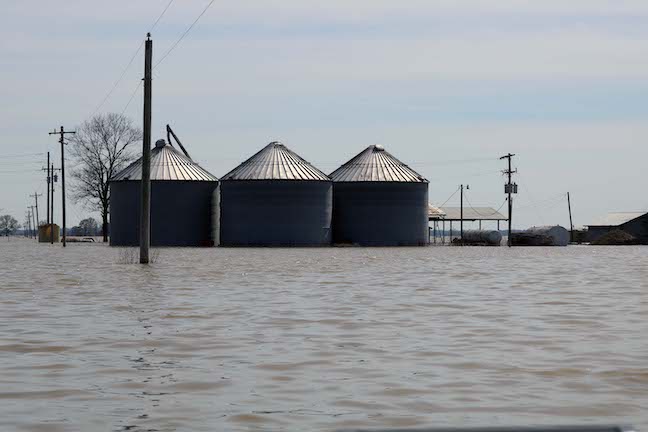
Further, Hyde-Smith points to the gulf in perspective between federal agency officials and longtime residents of the South Delta. “It is terribly frustrating when unelected career bureaucrats, the vast majority of which couldn’t point to the Yazoo Backwater Area on a map or begin to explain the area hydrology, try and tell Mississippians what is best for them, or what they cannot have. It is equally frustrating that the needs of those in the South Delta aren’t afforded the same respect the national media gives to the giant and well-funded environmental organizations.”
Faith no More
Following EPA’s November 2021 directive shuttering the pumps, the Yazoo Basin witnessed the return of Groundhog Day. Far removed from the finery of Capitol Hill or the comforts of an environmental headquarter office in New York, Oakland, Washington, D.C., or New Orleans, 20,000 South Delta citizens recognized a simple boots-on-the-ground truth: High water is always a day away.

“Lies, bribes, corruption, incompetence, or politics at its nastiest—take your pick because I’m ready to believe it all,” Stoner says. “Forget your political views about whether you are left or right, or liberal, independent, or conservative. Any fair-minded person can smell rot on this one.”
“Madness,” Nimrod concurs. “We’re seeing the lives of thousands of people used as pawns in dirty politics. While the inaction continues, the EPA knows—they know—another flood is on the way.”
Thorny Questions
EPA’s claims of Clean Water Act violations and environmental concern related to the Yazoo pumps are challenged by the testimony of residents within the Yazoo region. “Ask anyone who actually lives in the South Delta about what hurts the environment and they can speak to unreal destruction caused by flooding over and over,” Nimrod says. “Wildlife decimation, loss of trees, contaminated aquatics—take a look at the unbelievable losses in nature after a flood and tell me about the environment.”

Stoner poses thorny questions: “What position would the EPA folks, the boardrooms of the environmental groups, and the politicians take if their leaders actually lived in the Delta? What position would they take if their livelihoods and future were at risk? What position would they take if their roads, infrastructure, jobs, homes, small businesses, and farmland were on the line? Easy answer: They’d be begging for pumps.”
Science and Bureaucracy
As the 80-year saga rolls on, is the next chapter a class action lawsuit against EPA? “You can’t play in EPA’s game because EPA doesn’t play straight,” Nimrod says. “We will go around EPA, but it will take time.”
“I want the people of the South Delta to know the Levee Board isn’t giving up,” he emphasizes. “We’re sucker-punched and angry, but we will absolutely keep fighting for protection of people, infrastructure, farms, and wildlife. Pumps are the only solution, and we are not letting go.”
As Nimrod speaks, the flood clock ticks. “There are 20,000 people with anger and desperation levels approaching an all-time high,” he says. “It’s been decades and the government still won’t allow common sense to prevail.”
Nimrod’s sentiments are echoed by Hyde-Smith: “It baffles me that radical environmentalists do not understand that vast amounts of water trapped in a confined area can somehow disappear without a pumping station. I haven’t given up, and I won’t,” she says. “EPA’s recent action was certainly a significant bump in the road, but I have and will continue to push this administration and all agencies involved to find a way to get things back on track.”
The next South Delta flood is a reality Stoner acknowledges with a mix of disgust and disbelief. “My forefathers would be more disappointed in me giving up than I am disappointed in my own government, so I sure as hell will keep fighting and that’s a guarantee. People need to look around and wake up: When the government mixes science and bureaucracy, that’s a powerful tool of control.”
To read more stories from Chris Bennett (cbennett@farmjournal.com), see:
Tractorcade: How an Epic Convoy and Legendary Farmer Army Shook Washington, D.C.
Bagging the Tomato King: The Insane Hunt for Agriculture’s Wildest Con Man
How a Texas Farmer Killed Agriculture’s Debt Dragon
While America Slept, China Stole the Farm
Bizarre Mystery of Mummified Coon Dog Solved After 40 Years
The Arrowhead whisperer: Stunning Indian Artifact Collection Found on Farmland
Where's the Beef: Con Artist Turns Texas Cattle Industry Into $100M Playground
Fleecing the Farm: How a Fake Crop Fueled a Bizarre $25 Million Ag Scam
Skeleton In the Walls: Mysterious Arkansas Farmhouse Hides Civil War History
US Farming Loses the King of Combines
Ghost in the House: A Forgotten American Farming Tragedy
Rat Hunting with the Dogs of War, Farming's Greatest Show on Legs
Misfit Tractors a Money Saver for Arkansas Farmer
Government Cameras Hidden on Private Property? Welcome to Open Fields
Farmland Detective Finds Youngest Civil War Soldier’s Grave?
Descent Into Hell: Farmer Escapes Corn Tomb Death
Evil Grain: The Wild Tale of History’s Biggest Crop Insurance Scam
Grizzly Hell: USDA Worker Survives Epic Bear Attack
Farmer Refuses to Roll, Rips Lid Off IRS Behavior
Killing Hogzilla: Hunting a Monster Wild Pig
Shattered Taboo: Death of a Farm and Resurrection of a Farmer
Frozen Dinosaur: Farmer Finds Huge Alligator Snapping Turtle Under Ice
Breaking Bad: Chasing the Wildest Con Artist in Farming History
In the Blood: Hunting Deer Antlers with a Legendary Shed Whisperer
Corn Maverick: Cracking the Mystery of 60-Inch Rows


